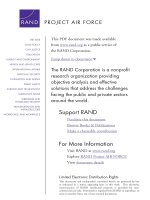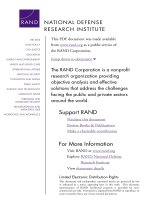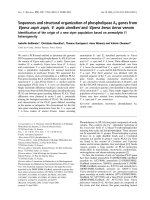American Carrier Air Power at the Dawn of a New Century docx
Bạn đang xem bản rút gọn của tài liệu. Xem và tải ngay bản đầy đủ của tài liệu tại đây (468.43 KB, 139 trang )
This document and trademark(s) contained herein are protected by law
as indicated in a notice appearing later in this work. This electronic
representation of RAND intellectual property is provided for non-
commercial use only. Permission is required from RAND to reproduce, or
reuse in another form, any of our research documents.
Limited Electronic Distribution Rights
Visit RAND at www.rand.org
Explore RAND National Defense
Research Institute
View document details
For More Information
This PDF document was made available
from www.rand.org as a public service of
the RAND Corporation.
6
Jump down to document
THE ARTS
CHILD POLICY
CIVIL JUSTICE
EDUCATION
ENERGY AND ENVIRONMENT
HEALTH AND HEALTH CARE
INTERNATIONAL AFFAIRS
NATIONAL SECURITY
POPULATION AND AGING
PUBLIC SAFETY
SCIENCE AND TECHNOLOGY
SUBSTANCE ABUSE
TERRORISM AND
HOMELAND SECURITY
TRANSPORTATION AND
INFRASTRUCTURE
WORKFORCE AND WORKPLACE
The RAND Corporation is a nonprofit
research organization providing
objective analysis and effective
solutions that address the challenges
facing the public and private sectors
around the world.
Purchase this document
Browse Books & Publications
Make a charitable contribution
Support RAND
This product is part of the RAND Corporation monograph series.
RAND monographs present major research findings that address the
challenges facing the public and private sectors. All RAND mono-
graphs undergo rigorous peer review to ensure high standards for
research quality and objectivity.
Prepared for the United States Navy
Approved for public release; distribution unlimited
American Carrier
Air Power
at the Dawn of a
New Century
Benjamin S. Lambeth
The RAND Corporation is a nonprofit research organization providing
objective analysis and effective solutions that address the challenges
facing the public and private sectors around the world. RAND’s
publications do not necessarily reflect the opinions of its research clients
and sponsors.
R
®
is a registered trademark.
© Copyright 2005 RAND Corporation
All rights reserved. No part of this book may be reproduced in any
form by any electronic or mechanical means (including photocopying,
recording, or information storage and retrieval) without permission in
writing from RAND.
Published 2005 by the RAND Corporation
1776 Main Street, P.O. Box 2138, Santa Monica, CA 90407-2138
1200 South Hayes Street, Arlington, VA 22202-5050
201 North Craig Street, Suite 202, Pittsburgh, PA 15213-1516
RAND URL: />To order RAND documents or to obtain additional information, contact
Distribution Services: Telephone: (310) 451-7002;
Fax: (310) 451-6915; Email:
Cover design by Peter Soriano
The research described in this report was prepared for the United
States Navy. The research was conducted in the RAND National
Defense Research Institute, a federally funded research and
development center sponsored by the Office of the Secretary of
Defense, the Joint Staff, the Unified Combatant Commands, the
Department of the Navy, the Marine Corps, the defense agencies,
and the defense Intelligence Community under Contract
DASW01-01-C-0004.
Library of Congress Cataloging-in-Publication Data
Lambeth, Benjamin S.
American carrier air power at the dawn of a new century / Benjamin S. Lambeth.
p. cm.
“MG-404.”
Includes bibliographical references.
ISBN 0-8330-3842-7 (pbk. : alk. paper)
1. Aircraft carriers—United States. 2. United States. Navy—Aviation. 3. United
States. Marine Corps—Aviation. 4. Afghan War, 2001—Aerial operations,
American. 5. Afghan War, 2001—Naval operations, American. 6. War on Terrorism,
2001– 7. Iraq War, 2003–—Aerial operations, American. 8. Iraq War, 2003–—
Naval operations, American. I. Title.
V874.3.L43 2005
359.9'4835'0973—dc22
2005023031
iii
Preface
This report presents the highlights of the U.S. Navy’s carrier air per-
formance during the first two major wars of the 21st century—
Operation Enduring Freedom against the Taliban and al Qaeda in
Afghanistan in 2001 and 2002 and the subsequent three-week period
of major combat in Operation Iraqi Freedom in early 2003 that fi-
nally ended the rule of Saddam Hussein. The report also addresses
ongoing modernization trends in U.S. carrier air capability. In the
first war noted above, U.S. carrier air power substituted almost en-
tirely for land-based theater air forces because of an absence of suit-
able shore-based forward operating locations for the latter. In the sec-
ond, six of 12 carriers and their embarked air wings were surged to
contribute to the campaign, with a seventh carrier battle group held
in reserve in the Western Pacific and an eighth also deployed and
available for tasking. The air wings that were embarked in the six
committed carriers in the latter campaign flew approximately half the
total number of fighter sorties generated altogether by U.S. Central
Command. As attested by the performance of naval aviation in both
operations, the warfighting potential of today’s U.S. carrier strike
groups has grown substantially over that of the carrier battle groups
that represented the cutting edge of U.S. naval power at the end of
the cold war.
The research findings reported herein are the interim results of a
larger ongoing study by the author on U.S. carrier air operations and
capability improvements since the end of the cold war. They should
interest U.S. naval officers and other members of the defense and na-
iv American Carrier Air Power at the Dawn of a New Century
tional security community concerned with the evolving role of U.S.
carrier air power in joint and combined operations. The study was
sponsored by the Director of Air Warfare (OPNAV N78) in the Of-
fice of the Chief of Naval Operations and was conducted in the In-
ternational Security and Defense Policy Center of the RAND Na-
tional Defense Research Institute (NDRI). NDRI is a federally
funded research and development center sponsored by the Office of
the Secretary of Defense, the Joint Staff, the unified Combatant
Commands, the Department of the Navy, the Marine Corps, the de-
fense agencies, and the defense Intelligence Community.
For more information on RAND’s International Security and
Defense Policy Center, contact the Director, James Dobbins. He can
be reached by e-mail at ; by phone at 703-
413-1100, extension 5134; or by mail at the RAND Corporation,
1200 South Hayes Street, Arlington, Virginia 22202-5050. More in-
formation about RAND is available at www.rand.org.
v
Contents
Preface iii
Figures
vii
Summary
ix
Acknowledgments
xvii
Acronyms
xxi
CHAPTER ONE
Introduction 1
CHAPTER TWO
Carrier Air over Afghanistan 9
Naval Aviation Goes to War
12
Carrier Air Operations in Retrospect
20
Key Operational Achievements
28
Lessons of the Afghan Air War
34
CHAPTER THREE
Operation Iraqi Freedom 39
The Air War Unfolds
43
Tanker Troubles
46
The Super Hornet’s Combat Debut
49
Highlights of the Carrier Contribution
52
On Balance
56
vi American Carrier Air Power at the Dawn of a New Century
CHAPTER FOUR
A New Carrier Operating Concept 59
How the Surge Concept Works
61
The Payoff for Combatant Commanders
66
CHAPTER FIVE
The Next-Generation Carrier 69
CHAPTER SIX
The Changing Face of American Carrier Air Power 79
Planned Super Hornet Improvements
80
Meeting the Needs of Electronic Warfare
82
The Promise of JSF
85
Evolving Air-Wing Composition
89
Toward a More Effectively Linked Force
94
CHAPTER SEVEN
Conclusions 99
Bibliography
105
vii
Figures
2.1. Carrier Presence on Station During Operation Enduring
Freedom
20
2.2. Preplanned Strikes vs. Time-Critical Targets
23
2.3. Hit Rate of Sorties That Dropped Munitions
24
2.4. Attacked Aim Points per Sortie
25
2.5. Precision-Guided vs. Free-Fall Weapons Expended
26
2.6. Time-of-Day Distribution of Target Attacks
27
2.7. Strike Sorties Through December 2001 by Service
29
2.8. Strike Sorties Through December 2001 by Aircraft Type
30
ix
Summary
The terrorist attacks of September 11, 2001, confronted the Navy,
like all of the other U.S. services, with a no-notice call to arms. The
sudden demand that they presented for a credible deep-attack capa-
bility in the remotest part of Southwest Asia where the United States
maintained virtually no access to forward land bases posed an unpre-
cedentedly demanding challenge for naval aviation. Within less than
a month after the attacks, the Bush administration and U.S. Central
Command (CENTCOM) planned and initiated a campaign to bring
down the Taliban theocracy that controlled Afghanistan and that
provided safe haven to the terrorist movement that perpetrated the
attacks. Code-named Operation Enduring Freedom, that campaign
was dominated by air attacks against enemy military assets and per-
sonnel, supported by teams of special operations forces (SOF) on the
ground working with indigenous Afghan opposition groups to pro-
vide U.S. combat aircraft with timely target location, identification,
and validation.
Carrier-based Navy and Marine Corps strike fighters operating
from stations in the North Arabian Sea substituted almost entirely for
Air Force land-based fighter and attack aircraft because of an absence
of suitable operating locations close enough to the war zone to make
the large-scale use of the latter practicable. Strike missions from the
carriers entailed distances to target of 600 nautical miles or more,
with an average sortie length of more than four and a half hours. The
farthest distance of 750 nautical miles from carrier to targets in
x American Carrier Air Power at the Dawn of a New Century
northern Afghanistan made for sorties lasting up to ten hours, often
with multiple mission tasking.
In all, from the start of hostilities on October 7, 2001, until the
end of major offensive operations on March 16, 2002, six carrier
battle groups participated in Enduring Freedom. Together, they con-
ducted around-the-clock operations against enemy forces in a land-
locked country more than an hour and a half’s flight north of the car-
rier operating areas in the Arabian Sea. Around 80 percent of the
carrier-based strike missions dropped ordnance on targets unknown
to the aircrews before launch. Of all Navy munitions dropped, 93
percent were either satellite-aided or laser-guided. Each carrier con-
ducted flight operations for roughly 14–16 hours a day, with overlaps
as needed to keep an average of three two-plane sections of fighters
constantly over Afghanistan for on-call strikes against emerging tar-
gets.
This sustained contribution of naval aviation to the campaign
(some 72 percent of all combat sorties flown in Enduring Freedom)
showed the ability of as many as four carrier battle groups at a time to
maintain a sufficient sortie rate to enable a constant armed airborne
presence over a landlocked theater more than 400 nautical miles away
from the carriers’ operating stations in the North Arabian Sea. In so
doing, it roundly disconfirmed suggestions voiced by some critics
only a few years before that the Navy’s carrier force lacked the capa-
bility to turn in such a performance. In conducting combat opera-
tions throughout the five-month course of major fighting in Endur-
ing Freedom, the participating air wings showed the substantially
improved capability that naval strike aviation had acquired since the
1991 Persian Gulf War. The predominant use of precision munitions
made the Afghan air war the most precise naval bombing effort in
history up to that time.
If Operation Enduring Freedom had been tailor-made for deep-
strike carrier air operations, the U.S led war against Saddam Hussein
in Iraq that followed a year later was no less so, at least with respect to
missions launched from the eastern Mediterranean. By the end of the
first week of March 2002, as Operation Iraqi Freedom neared, the
Navy had two carriers, USS Theodore Roosevelt and Harry S. Truman,
Summary xi
on station in the eastern Mediterranean and three more, USS Kitty
Hawk, Constellation, and Abraham Lincoln, deployed in the Persian
Gulf. In addition, USS Nimitz was en route to the Persian Gulf to
relieve Abraham Lincoln, which had already been on deployment for
an unprecedented nine months.
In all, more than 700 U.S. Navy and Marine Corps aircraft par-
ticipated in Iraqi Freedom. The average flight operations day aboard
each carrier was 16 hours for the first 23 days, after which it ramped
down to around 13-14 hours. Each air wing averaged 120-130 sorties
a day. Flight deck activity often continued without interruption
around the clock for long stretches, since strike aircraft and tankers
frequently recovered later than planned as a result of repeated re-
quests for close air support (CAS). As in Operation Enduring Free-
dom, alert strike packages were launched every day as previously un-
discovered targets of interest were identified.
The Iraq war set a new record for close Navy involvement in
high-level planning and command of joint air operations. At the op-
erational and tactical levels, the six participating carrier air wings were
better integrated into the air-tasking process than ever before, with
each wing having full-time representatives in CENTCOM’s Com-
bined Air Operations Center to ensure that the wings were assigned
appropriate missions. The wings also had ready access to a software
package aboard ship that automatically searched the complex daily air
operations plan for Navy-pertinent sections, eliminating a need for
mission planners and aircrews to study the entire document. Closer
cooperation in recent years between the Air Force’s and Navy’s weap-
ons schools yielded major dividends in improved joint-force interop-
erability, with the two services working together unprecedentedly well
in integrating their respective air operations.
Operations Enduring Freedom and Iraqi Freedom both saw a
sustained use of carrier-based air power well beyond littoral reaches.
As such, they represented something fundamentally new in the use of
naval air power. Unlike previous carrier air applications up to and
including Desert Storm a decade before, both wars saw an almost ex-
clusive use of precision-guided munitions by Navy fighters, signaling
the advent of a new era in which the principal measure of effective-
xii American Carrier Air Power at the Dawn of a New Century
ness is no longer how many aircraft it takes to neutralize a single tar-
get but rather how many aim points can be successfully attacked by a
single aircraft. The two wars also saw a pronounced shift from analog
to digital network-centric operations, with the Navy’s carrier forces
increasingly integrated into the digital data stream. In both wars, the
performance of the Navy’s carrier air wings offered a strong validation
of the final maturation of U.S. carrier air power after more than a
decade of programmatic setbacks and drift in the wake of the cold
war’s end.
Before the terrorist attacks of September 11, the Navy’s global
presence posture had been enabled by a highly routinized sequence of
maintenance, training, and unit and ship certification aimed at
meeting scheduled deployment dates that were all but carved in
stone. The sudden demands levied on the Navy by the terrorist at-
tacks, however, changed that pattern of operations irretrievably. Rec-
ognizing that the new demands of an open-ended global war on ter-
ror meant a need for more responsive naval forces able to sustain a
higher level of readiness, the Chief of Naval Operations (CNO) in
March 2003 announced a need for the Navy to develop a new Fleet
Response Concept (FRC) aimed at providing an enhanced carrier
surge capability.
That initiative was put into effect on the eve of Operation Iraqi
Freedom, which offered a timely opportunity to test the concept un-
der fire. As the war neared, the Navy had eight carrier battle groups
deployed, including USS Carl Vinson in the Western Pacific moni-
toring North Korea and China during the final countdown. Five of
those eight battle groups and air wings had participated in Operation
Enduring Freedom just a year before. With five battle groups on sta-
tion and committed to the impending war, a sixth en route to the war
zone as a timely replacement for one of those five, a seventh also for-
ward-deployed and holding in ready reserve, and yet an eighth carrier
at sea and available for tasking, a full 80 percent of the Navy’s carrier-
based striking power was deployed and combat-ready. With that
demonstrated performance having validated the FRC proposal, the
CNO in the early aftermath of Iraqi Freedom approved it and di-
rected its implementation as the Fleet Response Plan (FRP).
Summary xiii
The FRP seeks to increase the efficiency of maintenance and
training processes and procedures so as to heighten overall carrier
availability and readiness and to increase the carrier force’s speed
of employment. It envisages the augmentation of deployed carrier
battle groups with surgeable battle groups ready for deployment and
combatant-commander tasking, thereby yielding increased overall
force employability and earlier commitment of carrier striking power.
More specifically, it aims to provide combatant commanders with
what has come to be characterized as “six-plus-two” ready carrier
strike groups (CSGs). The “six” refers to deployable CSGs that can
respond almost immediately to tasking, wherever they may be in their
respective training schedules, in varying amounts of time up to 30
days. The remaining two represent near-combat-ready CSGs that can
deploy as needed on a more accelerated schedule than before, nor-
mally within around 90 days. That will constitute a larger overall na-
val air force complement able to respond to tasking, as opposed to a
smaller forward-deployed force fielded primarily to meet “presence”
requirements.
With respect to planned force modernization, the Navy’s
nuclear-powered Nimitz-class aircraft carriers have provided the na-
tion with effective service for more than 30 years. The design for
those carriers was completed during the 1960s. Since then, the carrier
force has not undergone an aggressive effort to fold cutting-edge
technology into the design of follow-on platforms. In light of these
considerations, and prompted by growing concern that the continued
absence of any significant progress in U.S. carrier design was inhibit-
ing operational capability improvements and the incorporation of
new technologies, the Navy in 1993 commissioned a future sea-based
air platforms working group to explore operational requirements,
available systems and technologies, and needed R&D initiatives for
defining and developing the next generation of carriers. That initia-
tive eventually resulted in the establishment of the Future Aircraft
Carriers (CVX) program.
Largely on the strength of subsequent analytical assessments and
findings, the Defense Acquisition Board (DAB) in June 2000 ap-
proved the Navy’s proposed plan to pursue a follow-on to the
xiv American Carrier Air Power at the Dawn of a New Century
Nimitz-class carrier that will be a large-deck, nuclear-powered ship
that was then designated CVNX. The DAB’s consensus was that
large-deck carriers were the preferable alternative for a broad range of
reasons having to do with operational effectiveness and flexibility.
Once commissioned in 2015, as its current development schedule
projects, the first of the Navy’s next-generation carriers, now called
CVN-21, will feature such radical innovations as an advanced reactor
and electrification of all auxiliary systems, which will increase the
ship’s electrical power-generation capability to three times that of the
Nimitz design and will also replace steam and hydraulic piping
throughout the ship. In addition, four electromagnetic aircraft launch
catapults will replace the earlier-generation steam catapults. CVN-21
will have a more efficient flight deck and advanced arresting gear for
aircraft recoveries. An abiding hallmark of its many design goals is the
provision of an adaptable infrastructure that will allow the incorpora-
tion of new capabilities as they develop. These measures will greatly
reduce life-cycle costs over the new carrier’s planned service life.
Among the many gains that have been registered in the leverage
of U.S. carrier air power over the past decade have been a proven
ability to surge a large number of CSGs (as many as eight out of 12
carriers and ten air wings) and to keep them on station for the dura-
tion of a major campaign; to attack multiple aim points with consis-
tently high accuracy on each combat sortie around the clock irrespec-
tive of weather; and—with the help of nonorganic tanking support—
conduct deep-strike missions well beyond littoral reaches and remain
on station for hours, if need be, in providing on-call interdiction and
CAS. These are new capabilities that would have been all but un-
thinkable during the final years of the cold war, even when the Navy
maintained 15 active carrier battle groups.
In the decade ahead, this process of evolutionary improvement
in naval strike warfare will continue unfolding in a way that promises
revolutionary advances in the potential of U.S. carrier air power. In
particular, the immediate years ahead will see a further sharpening of
the edge of the F/A-18E/F Super Hornet, a successor generation of
naval electronic warfare aircraft in the EA-18G, the introduction of
the E-2D Advanced Hawkeye offering significantly increased airborne
Summary xv
surveillance and battle-management capabilities, the Navy’s long-
overdue acquisition of an all-aspect stealth platform with the pending
introduction of the F-35C Joint Strike Fighter, and a leaner yet more
efficient and capable carrier air-wing force structure.
The Navy also is evolving from being a platform-centric to a
network-centric force. A recent CNO initiative called FORCENet
aims to tie together naval, joint, national, and ultimately coalition
information grids to achieve an unprecedented level of battlespace
awareness and knowledge management at all levels. This initiative
will allow improved situation awareness, quicker battle-damage as-
sessment, and real-time target reattack decisionmaking. It also will
provide a common operating picture up and down the chain of
command, from the most senior leadership all the way into the cock-
pits of individual shooters at the tactical level.
In sum, Operations Enduring Freedom and Iraqi Freedom
showed that the Navy’s carriers no longer operate as individual and
autonomous air-wing platforms but rather as a surged and massed
force capable of generating and sustaining however many consistently
effective sorties over time that an air component commander may
need to meet his assigned campaign goals. Unlike the relatively short-
range sorties flown during the largely demonstrative and punitive
strikes launched into Lebanon in 1983 and against Libya in 1986 and
in such subsequent contingency responses during the 1990s as Opera-
tions Deliberate Force, Desert Fox, and Allied Force, these were mul-
ticycle missions that lasted for as long as ten hours and that ranged
deep beyond littoral reaches into the heart of Afghanistan and Iraq,
the first of which was landlocked in the most remote part of Central
Asia.
Today, carrier aviation is not only a natural concomitant of the
nation’s status as the world’s sole surviving superpower, it also is the
one outstanding feature that distinguishes the U.S. Navy unequivo-
cally from all other naval forces around the world. The Nimitz-class
carrier has often been described as four and a half acres of sovereign
U.S. territory that can go anywhere the nation’s leaders may desire to
send it without needing a permission slip. For years, that characteriza-
tion was dismissed by critics of carrier air power as a mere slogan that
xvi American Carrier Air Power at the Dawn of a New Century
overlooked the fact that a carrier can be in only one place at a time,
irrespective of where a need for it might suddenly arise. That criticism
may have had merit throughout most of the cold war, when the Navy
typically kept only two or three carrier battle groups deployed at any
time, while the others and their attached air wings remained at home
in various states of maintenance and requalification training that ren-
dered them undeployable on short notice. That is no longer the case,
however, in today’s world of constant carrier surge capability under
the FRP. When U.S. naval aviation celebrates its 100th anniversary in
2011, carrier air power’s classic roles and missions will not have
changed greatly from those of the 20th century. Yet the nation’s car-
rier strike groups will have taken on a substantial qualitative im-
provement in their overall combat leverage with the completion of
the Super Hornet acquisition, the advent of the EA-18 and F-35C,
and the prospective introduction of unmanned surveillance and strike
aircraft into the Navy’s carrier air-wing complements.
xvii
Acknowledgments
This report has benefited from the helpful discussions I had during
the course of preparing it with then–Vice Admiral Timothy Keating,
Director, Joint Staff; then–Vice Admiral John Nathman, Com-
mander, Naval Air Force, U.S. Pacific Fleet; then–Rear Admiral
Lewis Crenshaw, Director, Assessments Division, OPNAV N81;
then–Rear Admiral Evan Chanik, Director, Programming Division,
OPNAV N80; Rear Admiral John Cryer, III, Commander, Naval
Space Command; then–Rear Admiral Mark Fitzgerald and Rear Ad-
miral Thomas Kilcline, successive Directors of Air Warfare, OPNAV
N78; Rear Admiral Richard Gallagher, Commander, Strike Force
Training, U.S. Atlantic Fleet; Rear Admiral William Gortney, U.S.
Fleet Forces Command; Rear Admiral Thomas Zelibor, Director,
Space, Information Warfare and Command and Control, OPNAV
N61; then–Rear Admiral James Zortman, Commander, Naval Air
Force, U.S. Atlantic Fleet; then–Rear Admiral (select) James Winne-
feld, Jr., Executive Assistant to the Vice Chief of Naval Operations;
Rear Admiral Richard Wren, OPNAV N78; Captain Martin Erdossy,
OPNAV N78; Captain Robert Nelson, OPNAV N3/5 (Deep Blue);
Captain Janice Hamby, OPNAV N70; Captain Charles Wright, Di-
rector for Naval Aviation Systems, Office of the Secretary of Defense
(Operational Test and Evaluation); then–Commander Calvin Craig,
OPNAV N81; Captain Kenneth Neubauer and Lieutenant Com-
mander Nicholas Dienna, both former Navy Executive Fellows at
RAND; Commander Andrew Lewis, Executive Assistant to the
Commander, Naval Air Force, U.S. Atlantic Fleet; Malcolm Taylor,
xviii American Carrier Air Power at the Dawn of a New Century
Principal Assistant for Air Warfare Plans, Analysis and Assessments,
OPNAV N783B; Lieutenant Commander Scott Moran, OPNAV
N780C3B; and my RAND colleagues John Birkler, James Dobbins,
Richard Hundley, and Rear Admiral Francis Lacroix, USN (Ret.). I
thank all of the above for their good insights and enthusiastic support
of this effort. I am especially grateful to Admirals Chanik, Crenshaw,
Fitzgerald, Gallagher, and Kilcline; Rear Admiral Matthew Moffit,
Commander, Naval Strike and Air Warfare Center; Captain Hamby;
Captain Wright; Captain James McDonell, USN (Ret.), former
commanding officer of USS John C. Stennis (CVN-75); Commander
James Bynum, Executive Assistant to the Commander, Naval Air
Force, U.S. Pacific Fleet; Commander Craig; and Malcolm Taylor for
their critique of all or parts of an earlier draft, as well as to Christine
Fox at the Center for Naval Analyses and Captain Nelson in Deep
Blue for providing me some useful documentary materials. I also
thank my RAND colleague Irv Blickstein and Adam Siegel of the
Northrop Grumman Analysis Center for their expert peer reviews of
the final manuscript and Chris Jantsch, Naval Air Systems Com-
mand, for his help in providing the images for the cover art.
I might note in passing that the report has been additionally en-
riched by a number of opportunities I was privileged to have in con-
nection with RAND work in earlier years to gain a broad range of
first-hand exposure to the world of naval air operations in the train-
ing environment. Those opportunities included six adversary training
sorties in the TA-4J with VF-126 out of NAS Miramar, California,
and NAS Fallon, Nevada, in 1980; three F-5F syllabus sorties with
Navy Fighter Weapons School (TOPGUN) at Miramar in connec-
tion with my attending the first week of the TOPGUN course in
1980; four F-14A sorties, including two arrested landings in USS
Kitty Hawk (CV-63), with VF-1 out of Miramar in 1983; 15 basic
air-to-air and surface-attack training sorties in the TA-4J with VT-24
and an advanced aircraft-handling sortie in a T-2C with VT-26 out
of NAS Beeville, Texas, in 1985; a TA-7C sortie with the Naval
Strike Warfare Center at Fallon in 1986; four air-to-air sorties in a
Navy F/A-18B from VFA-125 out of NAS Lemoore, California,
during the four-day Defensive Anti-Air Warfare Phase of the Weap-
Acknowledgments xix
ons and Tactics Instructor course offered quarterly by Marine Avia-
tion Weapons and Tactics Squadron One at MCAS Yuma, Arizona,
in 1986; an EA-6B mission orientation flight with VMAQ-2 at
MCAS Cherry Point, North Carolina, in 1987; and an F-14A+ sortie
with VF-24 out of Miramar in 1990. I remain deeply indebted to all
in the Navy’s and Marine Corps’ flight approval chains for civilians
during that ten-year window of time who made it possible for me to
acquire this invaluable hands-on experience. It has, at long last, pro-
duced a direct return on investment by the sea services nearly half a
generation later in a way that no one could have anticipated at the
time.
xxi
Acronyms
AAA Antiaircraft Artillery
AARGM Advanced Anti-Radiation Guided Missile
ABCCC Airborne Command and Control Center
AESA Active Electronically Scanned Array
AFB Air Force Base
AFSB Afloat Forward Staging Base
AFSOC Air Force Special Operations Command
AGM Air-to-Ground Missile
AIM Air Intercept Missile
AMRAAM Advanced Medium-Range Air-to-Air Missile
AOR Area of Responsibility
ASW Antisubmarine Warfare
ATFLIR Advanced Tactical Forward-Looking Infrared
ATO Air Tasking Order
AWACS Airborne Warning and Control System
BAMS Broad-Area Maritime Surveillance
BDA Battle Damage Assessment
BLU Bomb Live Unit
CAOC Combined Air Operations Center
CAP Combat Air Patrol
CAS Close Air Support
xxii American Carrier Air Power at the Dawn of a New Century
CBU Cluster Bomb Unit
CENTAF Central Command Air Forces
CENTCOM Central Command
CFACC Combined Force Air Component Commander
CFMCC Combined Force Maritime Component Commander
CJTF Combined Joint Task Force
CNO Chief of Naval Operations
CSG Carrier Strike Group
CTOL Conventional Takeoff and Land
CV Carrier
CVN Nuclear Carrier
CVNX Nuclear Carrier Experimental
CVW Carrier Air Wing
CVX Carrier Experimental
DAB Defense Acquisition Board
DMPI Desired Mean Point of Impact
DPG Defense Planning Guidance
ELINT Electronic Intelligence
EMALS Electromagnetic Aircraft Launch System
ESG Expeditionary Strike Group
EW Electronic Warfare
FAC Forward Air Controller
FAC-A Airborne Forward Air Controller
FLIR Forward-Looking Infrared
FMC Fully Mission-Capable
FRC Fleet Response Concept
FRP Fleet Response Plan
FSCL Fire Support Coordination Line
FTI Fast Tactical Imagery
Acronyms xxiii
FYDP Future Years Defense Program
GBU Guided Bomb Unit
GPS Global Positioning System
HARM High-Speed Anti-Radiation Missile
HMCS Helmet-Mounted Cueing System
HUD Head-Up Display
IADS Integrated Air Defense System
ICAP Improved Capability
ISR Intelligence, Surveillance, and Reconnaissance
JAST Joint Advanced Strike Technology
JCS Joint Chiefs of Staff
JDAM Joint Direct Attack Munition
JFN Joint Fires Network
JSOW Joint Standoff Weapon
J-UCAS Joint Unmanned Combat Aerial System
LANTIRN Low-Altitude Navigation and Targeting Infrared for
Night
LD/HD Low-Density/High-Demand
LGB Laser-Guided Bomb
LSO Landing Signals Officer
MAGTF Marine Air-Ground Task Force
MIDS Multifunction Information Distribution System
MMA Multimission Maritime Aircraft
MRC Major Regional Contingency
NAS Naval Air Station
NEO Noncombatant Evacuation Operation
NRAC Naval Research Advisory Committee
NSAWC Naval Strike and Air Warfare Center
OPNAV Office of the Chief of Naval Operations









